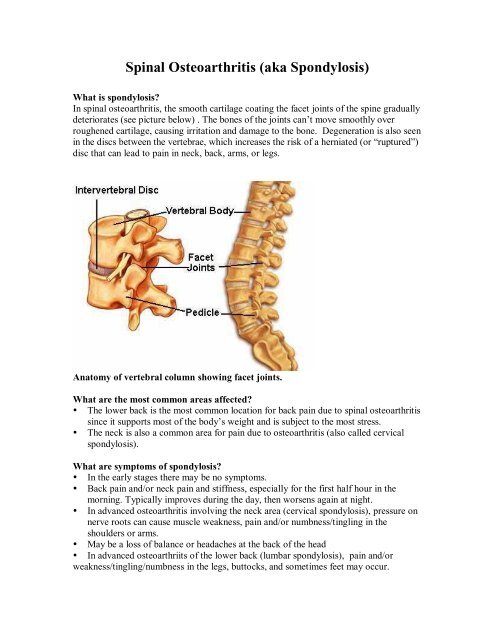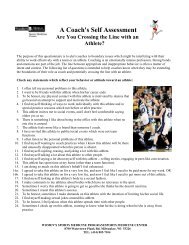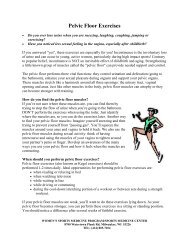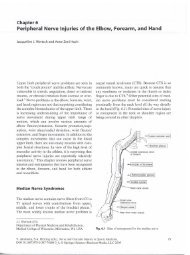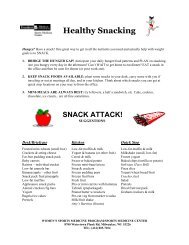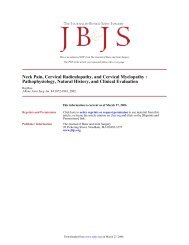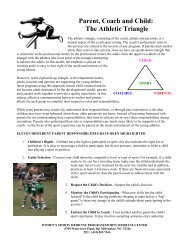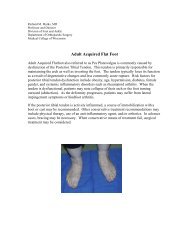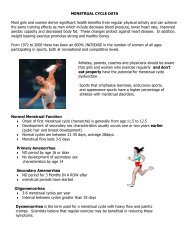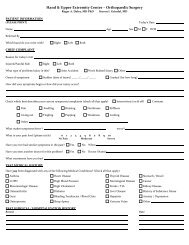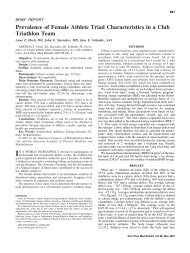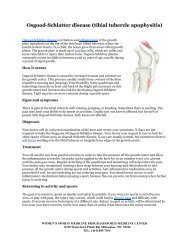Spinal Osteoarthritis (aka Spondylosis)
Spinal Osteoarthritis (aka Spondylosis)
Spinal Osteoarthritis (aka Spondylosis)
Create successful ePaper yourself
Turn your PDF publications into a flip-book with our unique Google optimized e-Paper software.
<strong>Spinal</strong> <strong>Osteoarthritis</strong> (<strong>aka</strong> <strong>Spondylosis</strong>)<br />
What is spondylosis?<br />
In spinal osteoarthritis, the smooth cartilage coating the facet joints of the spine gradually<br />
deteriorates (see picture below) . The bones of the joints can’t move smoothly over<br />
roughened cartilage, causing irritation and damage to the bone. Degeneration is also seen<br />
in the discs between the vertebrae, which increases the risk of a herniated (or “ruptured”)<br />
disc that can lead to pain in neck, back, arms, or legs.<br />
Anatomy of vertebral column showing facet joints.<br />
What are the most common areas affected?<br />
• The lower back is the most common location for back pain due to spinal osteoarthritis<br />
since it supports most of the body’s weight and is subject to the most stress.<br />
• The neck is also a common area for pain due to osteoarthritis (also called cervical<br />
spondylosis).<br />
What are symptoms of spondylosis?<br />
• In the early stages there may be no symptoms.<br />
• Back pain and/or neck pain and stiffness, especially for the first half hour in the<br />
morning. Typically improves during the day, then worsens again at night.<br />
• In advanced osteoarthritis involving the neck area (cervical spondylosis), pressure on<br />
nerve roots can cause muscle weakness, pain and/or numbness/tingling in the<br />
shoulders or arms.<br />
• May be a loss of balance or headaches at the back of the head<br />
• In advanced osteoarthriits of the lower back (lumbar spondylosis), pain and/or<br />
weakness/tingling/numbness in the legs, buttocks, and sometimes feet may occur.
How is spondylosis diagnosed?<br />
X-rays will indicate some vertebral (bone) abnormalities, allowing your doctor to<br />
determine the amount of degeneration. CT (computed tomography) or MRI (magnetic<br />
resonance imaging) scans may be done to better examine particular structures in the<br />
spine.<br />
How is spondylosis treated?<br />
Strengthening exercises to strengthen the back and abs are helpful. Strong muscles help<br />
support the spine, absorbing shock before it reaches the joints of the spine. Stretching<br />
exercises can decrease stiffness and ease back pain.<br />
• Pelvic Tilt: lower back stretching exercise<br />
Lie on back, knees bent, feet flat on floor. Tighten buttocks and abdomen, flattening<br />
small of back against the floor. Hold for a count of five. Slowly relax. Repeat five -<br />
fifteen times.<br />
• Basic Twist: back stretching exercise: loosens up lower back and relieves lower<br />
back pain.<br />
Lie on back, arms stretched out to the sides. Bend knees and bring knees up close to your<br />
chest. Take a deep breath and exhale as you slowly lower knees (keep knees together) to<br />
floor to the right or as close to the floor as is comfortable. Pause. Inhale as you slowly<br />
return your knees to chest. Exhale as you slowly lower knees to left side.<br />
Inhale as you return your knees to chest. Repeat about 5 times.<br />
• Hamstring (back of thigh) Stretch:<br />
Lie flat on floor with feet toward an open doorway. Lift right leg up so heel is resting on<br />
the wall of the doorway opening (left leg remains flat on floor through doorway opening.<br />
Bring buttocks closer to wall until you feel a slight pull in the back of the thigh. Hold for<br />
thirty seconds. Wait ten seconds and repeat 2 times. Repeat with left leg.<br />
• The Bridge: Strengthening exercises for several core muscle groups<br />
Lie flat on back; bend knees at 90-degree angle, feet flat on floor. Raise buttocks off<br />
floor, keeping abs tight (You can activate these abs by coughing - concentrate on<br />
contracting these muscles) Hold for a count of five. Slowly lower buttocks to floor.<br />
Repeat five times.<br />
• The Plank: Strengthening exercises for back and abdomen (also strengthens arms<br />
and legs)<br />
Lay on stomach, place elbows and forearms on floor. In a push-up position, balance on<br />
your toes and elbows. Keep your back straight and legs straight. (Like a plank) Hold<br />
position for 10 seconds. Relax. Repeat five to ten times. If this exercise is too difficult,<br />
use balance on your knees instead of your toes.<br />
• Leg Lifts: lower abdominal exercise:<br />
Lie flat on back. Lift leg about 45 degrees, hold for 3 seconds, switch sides. Do ten<br />
repetitions.<br />
For more stretching and strengthening exercises, please see the following websites:<br />
http://orthoinfo.aaos.org/fact/thr_report.cfm?Thread_ID=17&topcategory=Spine<br />
http://orthoinfo.aaos.org/booklet/view_exercise.cfm?Thread_ID=18&topcategory=Spine<br />
http://www.back-pain-management.com/back_exercises.html


